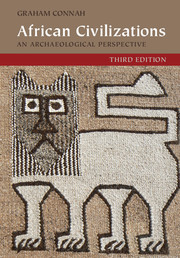Book contents
- Frontmatter
- Dedication
- Contents
- List of figures
- Preface and acknowledgements
- 1 The context
- 2 Origins: social change on the lower Nile
- 3 The Mediterranean frontier: North Africa
- 4 Sudanic genesis: Nubia
- 5 Isolation: the Ethiopian and Eritrean Highlands
- 6 Opportunity and constraint: the West African savanna
- 7 Achieving power: the West African forest and its fringes
- 8 Indian Ocean networks: the East African coast and islands
- 9 Cattle, ivory, and gold: social complexity in Zambezia
- 10 Central Africa: the Upemba Depression, Interlacustrine Region, and Far West
- 11 Settlement growth and emerging polities: South Africa
- 12 What are the common denominators?
- References
- Index
4 - Sudanic genesis: Nubia
Published online by Cambridge University Press: 05 November 2015
- Frontmatter
- Dedication
- Contents
- List of figures
- Preface and acknowledgements
- 1 The context
- 2 Origins: social change on the lower Nile
- 3 The Mediterranean frontier: North Africa
- 4 Sudanic genesis: Nubia
- 5 Isolation: the Ethiopian and Eritrean Highlands
- 6 Opportunity and constraint: the West African savanna
- 7 Achieving power: the West African forest and its fringes
- 8 Indian Ocean networks: the East African coast and islands
- 9 Cattle, ivory, and gold: social complexity in Zambezia
- 10 Central Africa: the Upemba Depression, Interlacustrine Region, and Far West
- 11 Settlement growth and emerging polities: South Africa
- 12 What are the common denominators?
- References
- Index
Summary
Other than Pharaonic Egypt, some of the earliest evidence for urbanization and state formation in Africa was along the middle Nile, in the region called Nubia. One of the best-known examples was Meroë, located about 200 kilometres north-east of the modern city of Khartoum, in Sudan. Mentioned as early as the fifth century BC by Herodotus (Powell 1949: vol. 1, 121), its antecedents lay in Napata and Kerma, the latter dating back to before 2000 BC, and it was succeeded by the kingdoms of Christian Nubia, which survived until the early second millennium AD, and by Islamic states that existed until recent times (Welsby 1996; 2002; Edwards 2004; 2007; UCL 2013).
At the beginning of the twentieth century, scholars attributed such developments to the influence in turn of Pharaonic, Ptolemaic, Roman, Byzantine, and Islamic Egypt, located to the north of the area. Later the emphasis was changed to one that stressed the indigenous character of Nubian achievements but acknowledged the contributions made to them by northern cultures. William Adams, the author of a 1977 monograph on the archaeology of this area, described Nubia as ‘the transition zone, between the civilized world and Africa’ and entitled his book Nubia: Corridor to Africa. According to Adams, the importance of this narrow corridor through the barren land of Nubia arose from the fact that it was for long the only dependable route across the great barrier of the Sahara Desert, a major road into the heart of Africa. The African interior contained resources much coveted by the outside world – gold, ivory, and slaves – but also other mineral, animal, and vegetable products (Adams 1984: 40). These could be tapped via the Nubian corridor. However, with the development of Red Sea shipping from the first millennium BC onwards, and of trans-Saharan camel caravans during the first millennium AD, the middle Nile Valley gradually lost its significance as a major world trade route. That role was finally destroyed by the expansion of maritime trade around Africa's coasts in the sixteenth and seventeenth centuries AD.
Both archaeological and documentary evidence support the idea of Adams' trade corridor, and the growth of cities and states was centred on it. This suggests that this part of Africa can provide us with an example of trade as a major stimulus towards the development of social complexity.
- Type
- Chapter
- Information
- African CivilizationsAn Archaeological Perspective, pp. 69 - 110Publisher: Cambridge University PressPrint publication year: 2015



